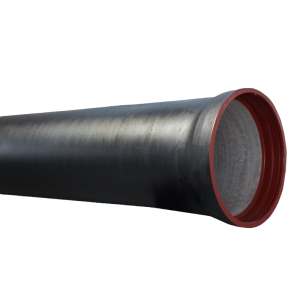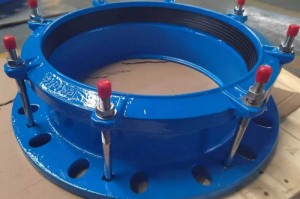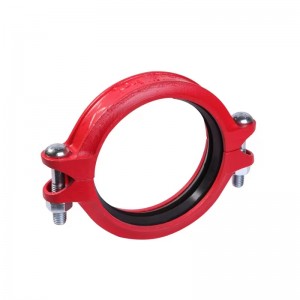An essential aspect of the ductile iron pipe design and functionality is the type of joints used to connect individual pipe sections. The joint type affects the ease of installation, the ablity to accommodate movement, crucially,the long-term integrity of the pipeline. Here are the common types of joints used with ductile iron pipes:
- Description: Push-on joints, also known as Tyton or slip joints, involve a simple mechanism where the spigot (male end) of one pipe is inserted into the bell (female end) of another with a rubber gasket placed in the bell.
- Advantages: These joints are quick and easy to assemble, require no special tools, and are flexible enough to accommodate slight angular deflections and ground movements.
- Applications: Widely used in water and wastewater systems where moderate pressures are anticipated
MECHANICAL JOINTS
- Description: Mechanical joints consist of a gland, a gasket, and bolts and nuts. The spigot end of the pipe fits into the bell of the connecting pipe, with the gasket creating a seal and the gland compressing the gasket through the tightening of bolts.
- Advantages: They offer flexibility in alignment and are suitable for applications where disassembly may be required. They can also accommodate slight angular deflections.
- Applications: Suitable for both water and gas distribution systems, especially in areas reguiring frequent maintenance or system reconfiguration.
- Description: Flanged joints use flanges attached to the ends of pipes, bolted together with a gasket in between to ensure a tight seal.
- Advantages: They provide a rigid and secure connection, allow for easy disassembly, and are idedl for pump connectionsand fittings where the pipeline connects to equipment.
- Applications: Commonly used in treatment plants, pump stations, and sections of the pipeline that require periodic inspection or maintenance.
- Description: This loint type involves a grooved indentation on the pipe ends, where a coupling is installed to connect the pipes. A rubber gasket within the coupling ensures the seal.
- Advantages: Grooved joints offer rapid assembly and disassembly, flexibility in movement, and can accommodate some angular and linear movement.
- Applications: They are often used in fire protection systems, HVAC, and industrial applications where easy modification of the piping system is a requirement.
MATERIAL GRADES
Ductile iron pipes are available in various material grades, each tailored to meet specific performance criteria and applications.These grades are defined by standards organizations, such as the American Society for Testing and Materials (ASTM), the International Organization for Standardization (lSO), and the European Committee for Standardization (EN).
The diferences in material grades typically involve variations in mechanical properties like tensile strength, yield strength,elongation, and hardness, as well as in chemical composition to enhance characteristics like corrosion resistance, durability, and impact resistance. Here are some of the common material grades for ductile iron pipes:
COMMON GRADES
ISO 2531/EN 545/EN 598 GRADES
- EN-GJS-400-15 (1S0 2531/EN 545): This grade offers excellent ductlity with a minimum tensile strength of 400 MPa and is commonly used in water and waste-water applications.
- EN-GJS-450-10 (IS0 2531/EN 545): With a higher tensile strength of 450 MPa, this grade provides a good balance between strength and ductility, suitable for higher-pressure applications.
- EN-GJS-500-7 (lS0 2531/EN 598): This grade is designed for sewage applications, offering increased strength and wear resistance with a minimum tensile strength of 500 MPa
- EN-GJS-600-3 (1S0 2531/EN 598): The highest strength grade commonly used for ductile iron pipes, with a minimum tensile strength of 600 MPa, suitable for high-pressure and industrial applications.
ASTM A536 GRADES
- 60-40-18: Similar to EN-GJS-400-15, it has a tensile strength of 414 MPa and is known for its outstanding ductility and impact resistance.
- 65-45-12: This arade offers a balance of strenath and ductility with a tensile strenath of 448 MPa, making it suitoble for avariety of applications.
- 80-55-06: With a tensile strength of 552 MPa, this grade is used where higher strength and moderate ductility are required
- 100-70-03: The highest strength grade in ASTM A536, offering a tensile strength of 689 MPa with lower ductility, is used in applications demanding high strength.
SPECIALTY GRADES
Some manufacturers produce ductile iron pipes in speciaty grades that are not explicitly covered by the standard classifications but are designed to offer enhanced properties for specific applications, such as:
- High impact resistance grades: Developed for regions prone to seismic activity or for pipes subject to heavy traffic loads
- Corrosion-resistant grades: Enhanced with additional alloying elements like copper, nickel, or chromium to improve corrosion resistance.
HOW TO CHOOSE THE RIGHT GRADE
Selecting the appropriate material arade for ductile iron pipes depends on various factors,including the type of fluid being transported, operating pressures, environmental conditions, and specific proiect requirements, Engineers must consider these factors in conjunction with the material properties to choose the most suitable grade that ensures the reliability, longevity, and performance of the piping system.
CORROSION OF DUCTILE IRON PIPES
Corrosion is a critical concern for ductile iron pipes, as it can significantly impact their longevity, functionality, and the quality of the water they transport. Understanding the mechanisms of corrosion, its effects, and strategies for mitigation is essential formaintaining the integrity of ductile iron pipe systems.
Mechanisms of Corrosion
- Galvanic Corrosion: Occurs when ductile iron is in contact with a more noble metal (e.g., copper) in the presence of an electrolyte, leading to accelerated corrosion of the iron.
- Pitting Corrosion: A localized form of corrosion that leads to the creation ofsmall holes or pits on the pipe surface. This isoften caused by the presence of chlorides and low pH levels in the water.
- Microbiologically influenced Corrosion (MlC): Caused by certain bacteria that can produce corrosive by-products, leadingto accelerated corrosion rates.
- Graphitic Corrosion: lnvolves the selective leaching of iron from the ductile iron, leaving behind a graphite matrix with little structural integrity.
Effects of Corrosion
- Reduced Pipe Life: Corrosion can significantly shorten the lifespan of ductile iron pipes, leading to premature failures and the need for replacements.
- Decreased Water Quality: Corrosion by-products can contaminate the water supply, affecting its taste, color, and safety
- Increased Maintenance Costs: Corroded pipes may require more frequent repairs and maintenance, leading to higheroperational costs.
Corrosion Mitigation Strategies
- Cathodic Protection: A method that involves attaching a sacrificial anode to the pipe or using an impressed current to protect the pipe from corrosion. This technique redirects the corrosive activity to the anode, which corrodes instead of the pipe.
- Coatings and Linings: Applying protective coatings externally and linings internally can shield the pipe from corrosive elements. Zinc coatings, for instance, provide galvanic protection, while epoxy or cement-mortar linings prevent directcontact between the water and the pipe interior.
- Control of Water Chemistry: Adjusting the pH levels and controlling the concentration of aggressive ions (such as chlorides)in the water can reduce corrosion rates.
- Corrosion lnhibitors: Adding corrosion inhibitors to the water can form a protective film on the pipe’s interior surface, slowing down the corrosion process
- Design Considerations: Designing the piping system to minimize stagnant water areas, ensure proper drainage, and avoid direct contact with more noble metals can help reduce the risk of corrosion.
- Regular Monitoring and Maintenance: lmplementing a regular inspection and maintenance program to detect early signs of corrosion and address them promptly.
LINING & COATING FOR DUCTILE IRON PIPES
Lining and coating are crucial protective measures for ductile iron pipes, extending their service life by preventing corrosion and ensuring the quality of the conveyed fluids. These treatments not only safe guard the pipe internally and externally against corrosive environments but also contribute to improved hydraulic peformance and reduced maintenance costs, Here’s an overview of common linings and coatings used for ductile iron pipes:
Internal Linings
Cement-Mortar Lining
- Application: Widely used for potable water distribution due to its excellent protection against tuberculation (the buildup of mineral deposits) and its pH-neutral properties, which protect the pipe from aggressive waters.
- Benefits: Enhances flow characteristics, reduces energy costs, and minimizes bacterial growth.
Polyethylene (PE) Lining:
- Application: Suitable for pipes transporting aggressive chemicals, sewage, and wastewater.
- Benefits: Offers outstanding chemical resistance, preventing the pipe interior from chemical attack.
Epoxy Lining:
- Application: Used for both potable water and industrial applications where chemical resistance and smooth surface for improved flow are required.
- Benefits: Provides a durable, seamless, and corrosion-resistant barrier.
Polyurethane Lining:
- Application: ldeal for abrasive and highly corrosive environments, such as in minina operations and sewaae applications
- Benefits: Offers excellent abrasion resistance and longevity, even in harsh conditions
ExternalCoatings
Zinc Coating:
- Application: A standard protective coating applied to the exterior of ductile iron pipes, often topped with a finishing layer of bituminous paint or a polymeric top coat for additional protection.
- Benefits: Acts as a sacrificial anode, corroding in place of the iron (galvanic protection) and significantly extending the pipe’s life.
Polyethylene Encasement:
- Application: Typically used in aggressive soil conditions. The pipe is encased in a loose polyethylene sleeve that acts as a barrier between the pipe and the surrounding soil.
- Benefits: Effective in preventing corrosion from soil aggressivity, with the additional advantage of being simple and inexpensive to apply.
Fusion-Bonded Epoxy Coating:
- Application: An external coating applied as a powder that melts and fuses to the pipe surface, used in both potable water and wastewater systems.
- Benefits: Offers excellent chemical resistance, durability, and protection against corrosion and UV degradation.
Polyurethane Coating:
- Application: Applied for external protection in highly corrosive environments and areas with high UV exposure.
- Benefits: Provides superior resistance to impact, abrasion, and chemical exposure, preserving the pipe’s integrity over time.
Post time: Jun-18-2025












